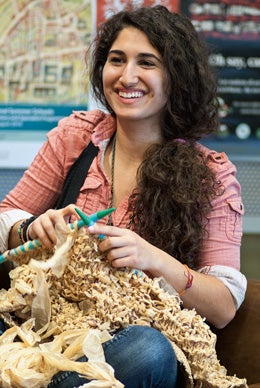Bagging the Plastic
 Everyone needs groceries, but what do Americans do with the estimated 100 billion plastic carrier bags they use annually? Plastic bags, especially high-density polyethylene ones, can remain on our planet for up to 1,000 years.
Everyone needs groceries, but what do Americans do with the estimated 100 billion plastic carrier bags they use annually? Plastic bags, especially high-density polyethylene ones, can remain on our planet for up to 1,000 years.
Although a growing number of environmentally-conscious consumers now carry their groceries in reusable cloth bags, Armine Tahmassian ’10, found a different way to recycle plastic bags to make an environmental point.
With advice from Lilla Samson, a painting and printmaking instructor in the Department of Art and Art History, the 21-year-old chose to look at the environment through art for her senior honors project. She was motivated by Natural Resource Science Professor Tom Husband’s environmental ethics class and by the 2008 Honors Colloquium on global climate change.
Tahmassian cut the bags into strips, twisted the strips with her father’s drill, rolled the twisted strips into a yarn-like ball, and began to knit. Her artwork begins with tight stitches, gradually opens to looser and looser stitches creating larger holes, and eventually unwinds so completely that it returns to plastic bags. The completed piece hung with three others works with accompanying text in Lippitt Hall this spring. Tahmassian called the plastic bag art Entropy.
“Entropy measures how disorganized/organized a system is,” she explained. “As stated in the second law of thermodynamics, entropy (or disorder) will increase over time in an isolated system. Therefore this piece portrays that principle. In other words, we, as humans, are increasing the amount of disorder on the Earth, which follows with this law; the conflict is that we are increasing this disorder at an escalating rate.”
Plastic bags were also incorporated in two of her three other 3-foot by 4-foot art pieces entitled “Land, Air, and Water,” all composed mainly of recycled materials such as bottle caps, dryer lint, red netting from fruit and vegetable bags, and styrofoam. They called attention to climate change, deforestation, and water pollution.
 Home
Home Browse
Browse Close
Close Events
Events Maps
Maps Email
Email Brightspace
Brightspace eCampus
eCampus


